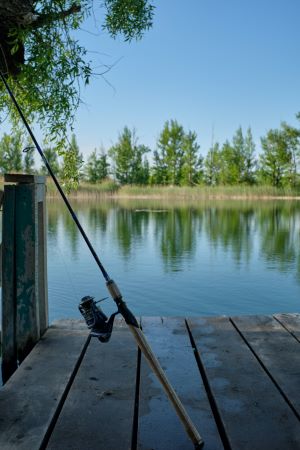The first trout many anglers target are stock rainbows, new fishermen can at times struggle to catch them. But they do not need to. With a few simple tricks they are actually quite easy to catch.
In this guide, I hope to answer many of the questions regarding fishing for stock rainbows in ponds and stillwater.
If I have one key piece of advice. When ever I fish ponds I like to keep moving and cover as much was as possible. I see way too many trout anglers stand on a pier or a point and refuse to move more than a few dozen yards.
7 Best Places to Find Stock Rainbow Trout in a Pond?
1 Start fishing close to the release site. When fishing release day. I always start fishing close to the release point. At first stock trout do not move too far and are likely to still be nearby.
2. Within a few hours stock trout can turn up almost anywhere as they explore their new home. Some will stick close to the release site, but others just keep swimming and swimming. I have seen stocked trout swim many miles away from their release site.
3. Watch other anglers. On release day, or when the pond is busy the best way to find where the trout are holding is to watch other anglers to see if they are catching trout or not. If some are having success, and others are not chances are they are casting to where the main school of trout are holding. Stocking day is usually busy, so watching other anglers is the quickest way to find fish.
4. Try and find moving water. A few days later. The trout have had time to disperse, and the crowds of anglers are usually gone. Stock rainbow trout might be dumb, but they still have the instincts of wild fish which means, they will try and find moving, oxygen rich water.
I always head towards any outlet, culverts or inlets. Rainbows are most likely to accumulate anywhere there is current. This could be as small as a weedy ditch or even storm water drain. Trout love moving water, and stock rainbows are no exception.
5. Fish around structure. My back up locations are structure and weedbeds. Stockies are still a bit dumb, but they still try to find where the food is, and weed beds provide a lot of insect life. Large groups can sometimes gather on the outside edge of weedbeds. Holdover trout, which have been in the pond for a while might even be patrolling the weedbeds themselves.
6. Trout seek protection in the shallows. Shallows, flats and small coves also seem to hold a larger than expected number of trout. There can even be a surprising number of large trout cruising in a flat only a couple of feet deep. Maybe they feel safer, in the shallows to keep away from predators like bass or pike, but they still gather in the shallows even in lakes where they are the top predators. I do not know why trout like shallow flats and coves, but they certainly frequent them.
7. When not feeding, the stockies trout like to hide. This can be beneath a overhang, or between the branches of a submerge tree, but more often such hides are not available. I these cases stock trout seek out the deepest channel or hole in the lake. Deep water provides good protection from aerial predators. While these trout might be resting, stock trout have massive appetites so are still willing to feed if a tasty morsel drifts by.
Do Rainbow Trout in Ponds Travel Alone or in Groups?
Underwater footage has shown that stock trout usually stick together in large groups. Recently released trout are scared and in unknown water so their natural behaviour is to stick together. Safety in numbers.
These groups do split, merge and split again. Predators such as eagles and large fish can also cause the school to scatter resulting in some trout become isolated and disorientated. These trout can turn up almost anywhere.
The longer the trout are in the pond, the more dispersed they become. Larger wild and holdover trout are more likely to be solo. While the smaller trout are more likely to stick to their schools especially when resting. They do disperse more while actively feeding.
How to find trout in a pond?
When fishing a new pond or lake. Only so much can be seen from the surface. So I like to fish as much water as possible. I usually choice an easy casting lure, and just walk the shoreline. I cast, retrieve walk, repeat.
I try my best to walk around the entire circumference fishing. The further from the car park and access points the better.
By covering as much water as possible, it increases my chance of finding pockets of trout which have not been disturbed by other anglers.
I rarely stand in one spot and just fish. More often than not that is a waste of time.
What Is the Best Lure or Bait to Catch Stock Rainbow Trout?
Honestly stock rainbows are dumb. They have been conditioned to eat pellets, so they will literally eat anything even remotely resembling the pellets they were fed.
If you already know where the trout are holding. I will start with power baits or even corn.
Pale brown baits usually works best because they resemble pellets. In general stock trout are unlikely to be fussy and presentation is more important than the exact bait.
I like to use power baits because they are buoyant allowing it to be fish off the bottom using a weight about a foot or two up the line. They are also much more durable than other popular baits such as cheese or corn. In general Stock trout shortly after release are not interested in wild, or natural food although nightcrawlers are still an effective option.
It is often frowned upon, and in some cases illegal. But, throwing a few handful of fish pellets into the lake is a proven way to get stock trout excited and feeding. Then just present your bait in the middle of the feeding frenzy.
After a few days, stock trout can become very hungry. They have been known to eat almost anything resembling food, even sticks. During this period, they are not usually difficult to catch.
Best Lures to Use to Catch Stock Rainbow Trout in Ponds?
There is often a lot of water to cover in lakes, so I like to use lures and spinners which are easy to cast. One of my go to favorites is a small size kastmaster. They a great lure for prospecting water. Simply cast out, let it sink for a couple of seconds and retrieve slowly. Most spoons work quite well to search for trout with.
Inline spinners also work well, but I sometimes feel loud ones can spook fish. It really depends how confident the stockies are feeling.
While jerkbaits are an excellent option for targeting wild trout, I do not feel there is much advantage using them to target stock rainbows.
Best Time of Day to Fish for Stock Trout?
The best time of day to catch stock trout is very temperature dependent. If the water is too cold, trout are less willing to feed. If the water is too warm they stop feeding.
In the summer, when the days are hot. I suggest fishing early in the morning when the water is at its coolest. If you must fish during the heat of the day, seek out areas where the water is a bit cooler. Such as at the mouth of a stream or in a deep hole. If the water temperature is consistently over 68f (20c) trout start to suffer heat stress and become difficult to catch. This is the reason why many authorities do not stock trout over the summer months. For more information check my guide on summer fishing here.
In the winter and early spring cold is the real concern and the trout become reluctant to feed. When the water is very cold, I suggest getting to the pond no earlier than 10am or once the water temperature is over 44f (6c). It is possible to catch trout in colder temperatures but it is a struggle.

